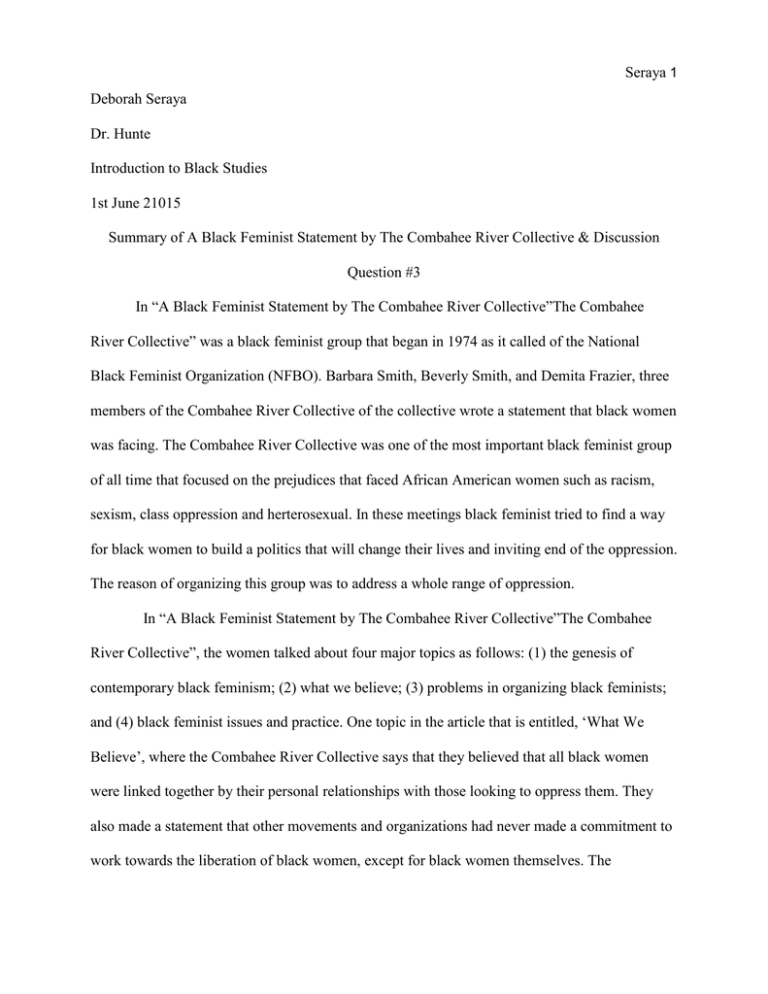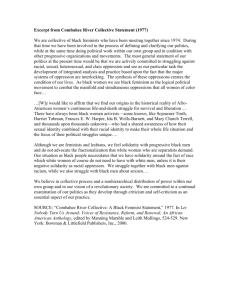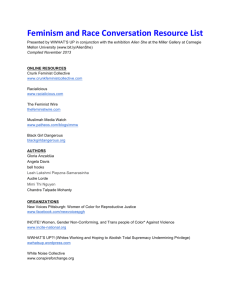File - Introduction
advertisement

Seraya 1 Deborah Seraya Dr. Hunte Introduction to Black Studies 1st June 21015 Summary of A Black Feminist Statement by The Combahee River Collective & Discussion Question #3 In “A Black Feminist Statement by The Combahee River Collective”The Combahee River Collective” was a black feminist group that began in 1974 as it called of the National Black Feminist Organization (NFBO). Barbara Smith, Beverly Smith, and Demita Frazier, three members of the Combahee River Collective of the collective wrote a statement that black women was facing. The Combahee River Collective was one of the most important black feminist group of all time that focused on the prejudices that faced African American women such as racism, sexism, class oppression and herterosexual. In these meetings black feminist tried to find a way for black women to build a politics that will change their lives and inviting end of the oppression. The reason of organizing this group was to address a whole range of oppression. In “A Black Feminist Statement by The Combahee River Collective”The Combahee River Collective”, the women talked about four major topics as follows: (1) the genesis of contemporary black feminism; (2) what we believe; (3) problems in organizing black feminists; and (4) black feminist issues and practice. One topic in the article that is entitled, ‘What We Believe’, where the Combahee River Collective says that they believed that all black women were linked together by their personal relationships with those looking to oppress them. They also made a statement that other movements and organizations had never made a commitment to work towards the liberation of black women, except for black women themselves. The Seraya 2 Combahee River Collective also argued that in order for the United States and different communities to really consider and take seriously the lives of black women, they had to examine how black women’s lives were affected and impacted by the oppression of racism, sexism, and class. Furthermore in another section called, ‘Problems in Organizing Black Feminists’, the Combahee River Collective discusses some reasons why there was difficulty organizing black feminist. They stated “the major source of difficulty in our politics work is that we were not just trying to fight oppression on one front or even two, but instead to address a whole range of oppression”(pg 244).This justifies that the biggest problem was fighting against a wide range of oppressions which was to have the minimal access to resources and power or to have class privilege. They also express that there was very low value placed on black women’s mind in society. Even though they had to overcome many obstacles, the Combahee River Collective fought and struggled to change the conditions of all black women. Moreover, the Combahee River Collective was dedicated to working on struggles such as sex, race and class which are all factors contributed to oppression. The women of the Combahee River Collective dedicated their lives to obtain justice for all black women from their oppressions and were an inspiration for many other women. The Combahee River Collective portrayed dedication and hard work which was very effective in raising awareness and making a historical impact in the history of black feminist. In “ Age, Race, Class and Sex: Women Redefining Difference” by Audre Lord, Lord discusses the conception of women being inferior due to their age, race, class, and sex. She notes the oppression that women have endured, especially Black women, and illustrates the difficulties that women face in society. Lorde’s point is that Black women are oppressed in two ways: Seraya 3 because they are Black and because they are women. At the beginning of the “ Age, Race, Class and Sex: Women Redefining Difference, Lorde points out that Western history has conditioned people to view differences as binary opposites“dominant,subordinate, good,bad, up,down, superior or inferior” (pg 845). She also argues that society measures superiority and goodness according to money and profit. As a result, the inferior groups in society are black people, “Third World people, working class people, older people, and women” (pg.845). Lorde describes herself as a “forty nine year old Black lesbian feminist socialist mother of two” (pg 845) and discusses her own feelings of inferiority. Moreover,Lorde argues that the pre existing picture which the oppressors have of the oppressed must change, and that this is the job of the oppressed; they must educate or reposition themselves in society. She believes that the whole society must change their way of seeing difference. The way they currently treat it is to “ignore it, and if that is not possible, copy it if we the oppressed think it is dominant, or destroy it if we think it is subordinate” (pg. 855). The differences concerning race, age, and sex are the reason behind the “separation and confusion.” Still, society is infused with certain ideas and thoughts about difference, and it would be difficult or perhaps even impossible to develop real change. Lorde mentions the American “mythical norm,” which is the image of the ideal American that society upholds; this figure is “white, thin, male, young, heterosexual, Christian, and financially secure” (pg.855). Society believes that this ideal is the source of power and superiority, and it is from this point of view that white women are oppressed. However, white women are only concerned with their own condition, which makes Black women become the other. Overall, these two articles “A Black Feminist Statement by The Combahee River Collective”The Combahee River Collective” and “ Age, Race, Class and Sex: Women Seraya 4 Redefining Difference” both have similarities points that both wants to make according the way they feel that people cannot ignore that the differences and inequalities do exist amongst age, race, class or sex groups. Lordes advises to change the system “the master’s tools will never dismantle the master’s house”. She believes we can’t do it unless we step outside of it.Women need to collectively acknowledge the difference in others if they truly want to fight for an end to oppression. Seraya 5 Discussion Question # 3 1. The Combahee River Collectives Statement was to fight for their own rights and demand for their equal rights Do you believe that Black women have these rights today in society? 2. Would the combahee River Collectives be considered reformist or Revolutionary feminist?Why 3. How does The Combahee River Collectives compare to the other authors we’ve read about? 4. Should race and gender politics be kept separate? 5. The collective makes a number of claims about the relationship between sex and race. According to the collective, how does sexual identity combine with racial identity in the lives of African American women? How do sexual identity and racial identity combine in your personal experience? 6. "The reaction of black men to feminism has been notoriously negative." (328) How does this view compare with society today? Seraya 6 Work Cited Collective, Combahee River. 'A Black Feminist Statement'. na, 1982. Lorde, Audre. "Age, race, class, and sex: Women redefining difference."CULTURAL POLITICS 11 (1997): 374-380. Lorde, Audre. "Age, race, class, and sex." Sister outsider 116 (1995).






